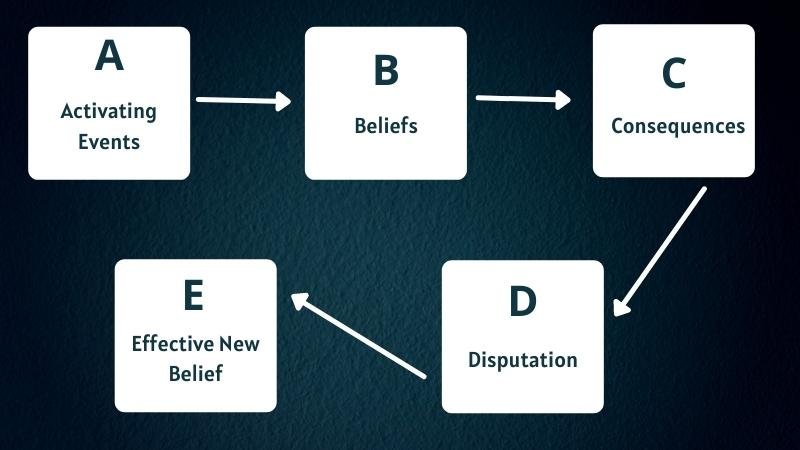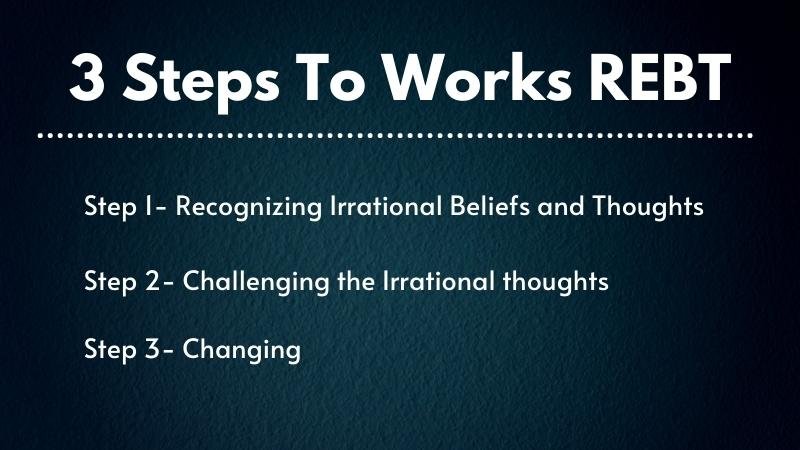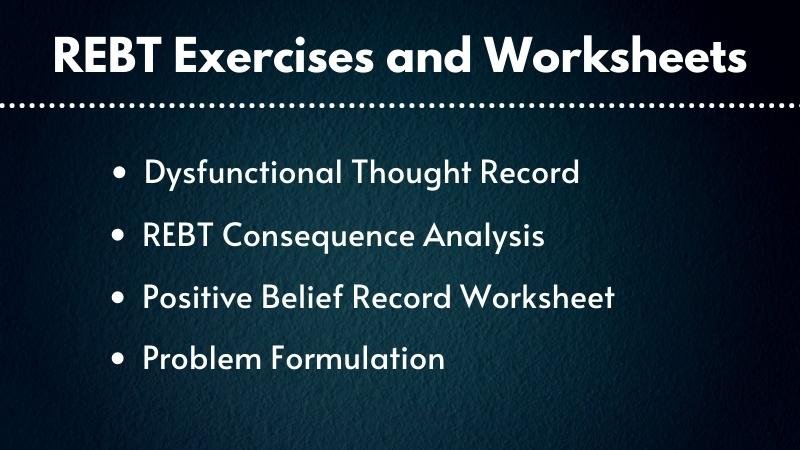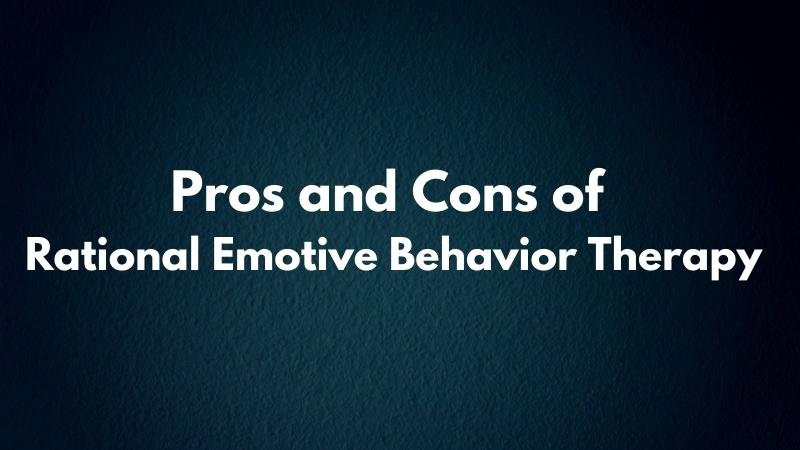What is Rational Emotive Behavior Therapy?
Rational Emotive Behavioral Therapy, also known as REBT, is a part of Cognitive Behavioral Therapy (CBT). It is considered the second wave of the development of CBT.
REBT is an approach that helps people to identify thoughts and feelings that are self-defeating, question the rationality of those, and replace those beliefs with something that is more rational and helpful to deliver more positive consequences.
According to REBT, the behavior and emotions of people are directly related to the beliefs or thoughts of them. That’s why therapists who conduct REBT sessions at first help the patients to identify the irrational thoughts and beliefs. Once those are identified, they work with the patients to measure the rationality of those. In the case of irrational beliefs, they work together to alter or change the beliefs into rational ones.

What are the Three Main Beliefs of REBT?
The three main beliefs of REBT refer to the three common irrational beliefs that we all have. The way we express those are different because of our ways of approaching them, but the basics are the same. These are related to us, what we do, others around us, and everything. Below are the three main beliefs that we all have according to REBT.
- I must do good and those should be approved by everyone or I am not good at my work.
- Other people must treat me as I want them to treat me, fairly, considerately, and kindly. If they don’t do this, they should be punished because they deserve it.
- I must get what I expect, and just when I expect it. Similarly, I must not get something that I haven’t wanted. If I don’t receive what I want, it is not fair. It is terrible and I don’t like it at all.
These are the three main beliefs that lead us to do negative activities in response to an event or situation. The first one is liable for guilty, anxiety, shame, and depression. The second one leads to negative actions against others, for example- aggression, anger, rage, and acts of violence. The third one is responsible for procrastination and self-pity.

What Is The Ellis ABC Model?
Ellis has established and defined three guiding principles. The guiding principles are established based on the belief that- people are unaware of the deep irrational thought they have and how those are affecting them through their regular activities.
The three guiding principles are also called the ABCs of REBT. The ABCs of REBT are given below-
- A- Activating Events: The first thing is detecting the event or event that is the reason behind the negative response. The response can be emotional or behavioral.
- B- Beliefs: The second thing is identifying the core belief. Belief or thought is the thing that helps the emotional or behavioral response to come out.
- C- Consequences: A and B, activating events and belief, together produce a consequence. The consequence is not necessarily the response that is seen. But the consequence can be a response that is not seen. The consequence can be a long-term one, like depression or low self-esteem, or a short-term one, for example- a sudden clash.
The ABC model is further expanded to D and E which has made thins an ABCDE model that represents what REBT does more perfectly. Below are the two new principles-
- D- Disputation: The irrational beliefs that are creating the consequences should be disputed with the use of rational and more stable thoughts and beliefs.
- E- Effective New Belief: The new and rational thoughts that are disputing the irrational thoughts should be effective enough to replace irrational properly. These rational thoughts are positive and able to keep the consequences less impactful on the mind and life.
What is the Goal of Rational Emotive Behavior Therapy?
REBT stands on a single goal. It is very clear and straightforward, just like the techniques in it. The main goal of REBT is-
To help the patients to avoid the problems they’re facing by identifying the irrational thoughts and beliefs behind those, challenging those, and replacing those with positive and rational thoughts and beliefs.
The goal of RBT takes us to the way it works. REBT therapy is designed depending on the main goal of REBT. Below is the way how REBT works.

How Rational Emotive Behavior Therapy Works
The main focus of REBT is the rationality of the thoughts and beliefs of the patients. Life events and other experiences have a great impact on mental health, but REBT also adds that the irrational thoughts of people are also a major factor that contributes to mental health issues. So, it works on those irrational thoughts and the ways to change those thoughts.
Rational Emotive Behavior Therapy works following three main steps. These are given and described below-
Step 1- Recognizing Irrational Beliefs and Thoughts
As REBT believes that irrational thoughts have a great impact on the mental condition of a person, it focuses on recognizing irrational beliefs at the very first step of the process. However, to identify those, obviously, the therapist and the patients should have a relation of minimum trust and comfort.
In most cases, irrational thoughts and beliefs are expressed as absolutes, which means, the thoughts that contain ‘I must do it or ‘I must not do it.
Thoughts and beliefs like these don’t let someone accept reality. In real life, everything won’t go according to someone’s beliefs. As a result, when something happens that was not expected, they tend to express negative behavior.
Also, these types of beliefs don’t provide any zone of acceptance. According to these beliefs, everything should happen according to their preference. And when the reality doesn’t match such high expectations, negative expressions come out. Negative expressions like low self-esteem, disappointment, anxiety, regret, etc. are the results of such beliefs.
In the long run, they remain unsatisfied with what they have and unfulfilled in their life.
So, at the very first stage, REBT focuses on finding out such irrational beliefs that give a vibe of absoluteness. The ‘I must do it, ‘this can’t have happened, ‘they must avoid doing this and such types of thought are identified and listed.
To find out such beliefs, the therapist asks questions or uses some other REBT techniques that work great to dive deep inside the minds of the patients and identify irrational beliefs. The techniques are developed from the very beginning of REBT.
Step 2- Challenging the Irrational thoughts
Now it is time to challenge irrational thoughts and the whole thing must be done strongly and straight, without any hesitation. The therapist is the person who helps to do this. He/she has to be straightforward and strong in his/her approach.
This should be done in a way so that the irrational thoughts can’t come back later. Direct conversation and REBT technique- both ways are used to challenge these thoughts.
Step 3- Changing
This is a very tough phase, even tougher than challenging the thoughts. For the patients, it is not so easy to accept others’ opinions replacing the opinion that they have had for decades. So, the therapist has to face a tough situation to bring the change.
Also, even if the patients want to change, their response to situations will not match the expected response on the first try. So, they might feel low and leave trying. It is very common because acting consciously is not always possible.
When they make mistakes, they become low. Here, the therapist has to make them understand that it is very common to be failed at primary approaches.
The changing phase is really struggling for the patients and tough for the therapist. But together they can make things happen. When the patients learn from the mistakes they’ve made, they can change their irrational thoughts into more rational beliefs.
What is REBT Used to Treat?
Rational Emotive Behavior Therapy or REBT is being used to treat a lot of problems and issues. Below is a list of some common problems that are being treated by REBT.
- Suicidal thoughts and depression
- Low self-esteem
- Panic disorder/Panic attack
- PTSD
- Generalized anxiety disorder
- Sexual abuse recovery
- Eating disorder
- Autism spectrum disorder
- Different types of phobias
- Obsessive-compulsive disorder
- Behavioral problems including anger issues, self-sabotage
- Substance addiction
- Game addiction
- Porn addiction
- Severe or chronic stress
- Relationship issues
- Marital problems
- Performance anxiety
- Insomnia
- Grief and loss
Also, there are many other disorders that can be fixed or reduced with the help of REBT.

Rational Emotive Behavior Therapy Techniques
The techniques of REBT can be divided into three main types. The three types are counted as the response to the three guiding principles of REBT. Below are the types of techniques that are mainly used in REBT.
Problem-solving Techniques (used to address the Activating events)
These techniques are mainly used in order to identify the activating events responsible for the negative response. Also, these help to cope with the activating events to reduce the impact of those. Some common problem-solving techniques are-
- Social skills
- Problem-solving skills
- Decision-making skills
- Assertiveness
- Conflict resolution skills
Cognitive Restructuring Techniques (used to respond to the Beliefs)
These techniques are ways to change irrational beliefs. These help the patients to change their minds about the activating events. As a result, their internal beliefs and thoughts also become changed gradually. Some of the commonly used cognitive restructuring techniques are-
- Logical or rationalizing techniques
- Reframing, looking at things from a different viewpoint
- Guided imagery and visualization
- Disputing irrational beliefs
- Using humor and irony
- Exposing to whatever seems scary
Coping Techniques (used to fight the Consequences)
Coping techniques help the patients to deal with the emotional consequences that happen inside their minds as a response to the Activating events and their Beliefs. Using these techniques, the patients build up their own ways of dealing with the consequences. Some of the common coping techniques are-
So, these are the common techniques used in Rational Emotive Behavioral Therapy. Besides these, there are many more techniques that can be used.
Not all the techniques above are used for everyone who is taking REBT. Depending on the experience of the therapist and the patient’s situation, the combination of the techniques varies.

Rational Emotive Behavior Therapy Exercises and Worksheets
For REBT, therapists may use a lot of exercises and worksheets in order to identify, challenge and replace irrational thoughts. These worksheets and exercises have been developed gradually with time.
Below are some of the common exercises and worksheets used in REBT. There are a lot more. All of these help the therapists to find out the activities that help to identify, challenge and replace damaging thoughts and beliefs.
Dysfunctional Thought Record
Dysfunctional Thought Record is a worksheet that is used a lot in REBT. This is the sheet that identifies and keeps records of irrational thoughts. Also, it contains potential alternative thoughts too. This is like a journal where the patients keep a record of irrational thoughts to clearly see the issues and find out the source.
This record comes with seven columns. Each of the columns contains different but related contents. The columns and the contents are given below-
- Column 1- The name of the first column is ‘Date and Time’. It contains the date and time when an irrational thought has come in the mind.
- Column 2- It is named ‘Situation’. Here, the patient lists the situation in which he/she was when the irrational thought came.
- Column 3- The third column is named ‘The Thought’ and includes the automatic thought that came to mind.
- Column 4- The name of this column is ‘Emotions’. This column includes the emotions that they’ve felt because of the thought.
- Column 5- This includes the cognitive distortions they’ve felt in the mind when the situation was going on. The name of the column is ‘Cognitive Distortions’.
- Column 6- This column is named ‘Alternative Thoughts’ and contains some alternative thoughts found through brainstorming that could replace the automatic dysfunctional thoughts.
- Column 7- The last column is called ‘Outcome’ and contains the outcome of the situation, thought, and action.
This exercise helps the patient to identify their response to the situations clearly and consciously find out some alternative ways to think about situations. Thus, a regular record of thoughts and situations help them to develop a more conscious, positive and rational approach towards different situations.
REBT Consequence Analysis
REBT Consequence Analysis is a technique or worksheet that helps patients to find out the consequences of the irrational beliefs they have. Mainly the consequences of the important things in their life are discussed here so that they can understand the necessity of changing some thoughts.
The REBT Consequence Analysis worksheet comes with three sections. Each stage has its own content to write.
The very first section of the worksheet comes with a label called ‘Situation and Target’. In this section, the patient writes about a major issue that they’re facing. Besides, he/she also writes the most important values and goals regarding the situation.
The second section is named ‘Short-term Consequences’. Here, the patients write the short-term benefits and costs caused by their usual thoughts and behavior. The benefits and costs should be written separately.
The third section of the worksheet is named ‘Long-term Consequences’. This section is similar to the previous one but it contains long-term benefits they gain and costs they’ve to face because of the usual thoughts and behaviors they have.
When the sheet is filled up and the possible benefits and costs are written, now the patient has to answer a question- “Find out the best outcome in the long run.” This worksheet helps the patients to understand that their irrational behaviors and thoughts are resulting in something in the long run that is not their goal or expectation.
As a result, they understand the reasons why they should accept and implement some changes in their thoughts and behaviors.
To make them aware of the pros of rational behavior, the therapist can help them to fill up the sections again using more rational and positive thoughts and behaviors. This will help the clients to be more open to accepting the positive and rational thinking pattern.
Positive Belief Record Worksheet
The Positive Belief Record Worksheet is a worksheet that helps patients directly challenge irrational beliefs. To challenge those, it uses reasons for having rational belief and thought.
The worksheet is really simple. At the very top of the sheet, there are two boxes. One contains the current or irrational behavior and another contains a rational behavior that can replace the irrational one.
Below the boxes, there is a blank space with a heading- ‘Reasons that Support the New Belief’. In the blank space, the patient writes at least 10 facts that support the new belief. Also, the facts can be something that directly challenges the old belief. The facts, reasons, or pieces of evidence can be anything, like- someone’s advice, experienced events, or anything.
This is the way that directly challenges the irrational or old belief with enough reasons against it. And the most important thing is, most or all of the facts, reasons, or pieces of evidence come from the patient’s end. So, he/she can’t avoid the facts and ignore the need to replace the old thought with a new one.
Problem Formulation
The problem Formulation worksheet is another one that helps the patients to identify the outcome of their usual response to a situation and compare the outcome to the outcome of a positive and rational response to the same situation.
The very first section of this worksheet contains a situation or activating event that creates an emotional response. The client should describe the situation with 4 major components-
- A proper description of the situation
- Mark the critical factor (the specific reason or specific part of the event that affects him/her)
- The bodily sensations they experience during the event
- Explain the event using a symbol or metaphor to explain how the event feels
These 4 things are a must while fulfilling this section.
The next section covers the natural or regular response to that specific event.
In this section, the patients should list the emotion, thoughts, and images they feel when the event takes place (things that are happening in their body and mind at the time of the event). Also, they have to write their response or the way they wanted to respond to the event.
The third section contains a rational and healthy response to that specific event.
Here, at first, the patients should target an emotion that should be achieved to ensure a healthy response to the event. After that, they have to list how they would think and respond to feeling the emotion.
This sheet compares two types of responses directly and makes the patients understand which one is a healthy response.

Pros and Cons of Rational Emotive Behavior Therapy
Just like everything, REBT also has some advantages and disadvantages. After knowing this much about REBT, now it is time to talk about the advantages and disadvantages of this treatment procedure.
Pros of REBT
- REBT focuses on thoughts and behavior. These are accessible. Many treatments or therapy models focus on assessing past memories and experiences which are not easily accessible but rather faded and almost forgotten. In comparison to those, this is the main advantage of REBT it works with the thoughts, beliefs, and behaviors that are definite, distinct, and accessible.
- REBT is an evidence-based treatment procedure, which means it is proven and backed by scientific evidence. Thus, it ensures a better result than many other treatment procedures. According to a number of researches, it is proven that REBT cures many issues effectively.
- REBT ensures long-term effectiveness, which means REBT has an impact on the patients for a longer period.
- REBT doesn’t include spirituality in its treatment procedure. As a result, people from all types of beliefs can receive this treatment without any issues. They don’t need to change their spiritual belief.
- In the process of REBT, psychoeducation is an important part. REBT teaches patients how to treat themselves. As a result, the patients are not dependent on someone after a certain period. This makes them confident and helps them to recover more quickly.
- Compared to many other therapies, REBT requires only a few sessions to bring an effective result. On average 12-15 sessions are enough to help the patients to solve the problem.
- REBT includes the patient’s participation in the therapy process. As a result, it becomes more effective and efficient.
Cons of REBT
- REBT is not much effective in treating schizophrenia, personality disorder, and similar severe psychological disorder.
- Treating using REBT is harsh on the patients. It identifies irrational thoughts and challenges those. This process requires the therapists to be harsh to the patients.
- In REBT, the patients should be willing to work for fixing the issue. It includes some homework that most of the patients don’t want to do. But to make the therapy effective, homework is an important thing. So, if the patients are not willing to work on the issue, REBT can’t be that effective. Moreover, creating pressure on the patients may result in negativity.
- Some techniques used in REBT are degrading and forceful. Some techniques are difficult to enjoy from the patients’ side. The patients should learn and accept the necessity of the techniques. Otherwise, techniques like shame-attacking exercises won’t be fruitful at all.
- People who don’t have a high tolerance level and acceptability will struggle while receiving REBT. In fact, REBT can make the relationship between the therapist and the patients worse.
So, these are the basic pros and cons of REBT that you should know. If we check the cons, we must say that REBT is not for everyone. It is the responsibility of the therapist to know about the patients properly and try to understand if they are capable of taking the pressure of REBT or not.
How Long Does REBT Therapy Take?
There is no set length for REBT therapy. It all depends on the patient’s problem, situation, progress, and ability to learn. Typically REBT is a short-term process that might take 12-15 sessions. This is an average count. Depending on the factors, the number of sessions may vary. Each session can be of 40 to 60 minutes.
The main goal of REBT is to identify irrational beliefs, challenge those and replace those. An important part of this process is psychoeducation, which means teaching the patients how to continue the process. Once the patient learns to treat himself/herself, the sessions are over because the patient has to continue the practice for her whole life. Here, the therapist has nothing else to do.
So, when the question is about the time REBT takes to solve a problem, there is not any definite answer. But we can make an estimation that it takes around 12-15 sessions.
Typically, the therapists talk about how many sessions you’ll need after conducting 1-2 sessions. In these primary sessions, they check the patient’s ability to learn and accept, the current situation, and many other things which let them make a prediction about the number of sessions.






